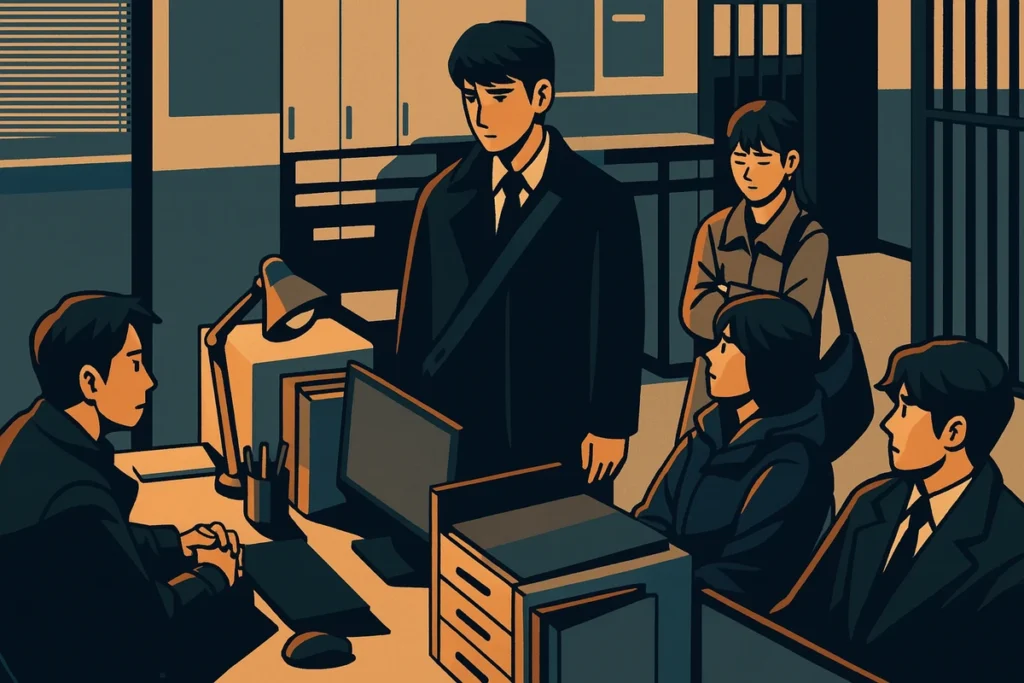[Image Source] AI illustration by DALL·E
TL;DR – Romance, without saying the word.
In *Be Melodramatic*, love hides in silence. Eun-jung stops Sang-soo from pouring his own drink—not out of politeness, but as a quiet connection.
Korean drinking etiquette becomes emotional code: gestures like touching a glass, raising it to someone’s eyes, or saying “떼” speak volumes.
This is the language of “썸”—where no one confesses, but everyone feels it.

1. Scene Snapshot
A quiet bar table with two half-filled soju glasses and too many unsaid words. Eun-jung, barely holding herself together after a loss, sits across from Sang-soo, the man who never pressures her, but never leaves either. He pours her a drink. She touches his glass—not for flirtation, but as a quiet protest against him pouring his own. A cultural ritual disguised as intimacy. Then he raises his glass to her eyes instead of clinking. It’s awkward, poetic, and oddly romantic. She stares. He hesitates. She finally says, “Move it.”
This is not a love confession. It’s what comes before. The quiet tension of 썸, the Korean “something” that might become love—or never will.
📺 Watch the original scene here
[Source] YouTube, @DRAMAVoyage
2. Micro-Dialogue
2-1. 네 잔부터 채울게.
I’ll fill your glass first.
2-2. 잔 부딪칠까?
Want to clink glasses?
2-3. 잠시 말이 끊긴다.
The conversation pauses.
2-4. 그거 내려.
Put that down.
3. Culture & Subtext
The phrase “썸을 타다” doesn’t come with a declaration of love. It lives in gestures, glances, and quiet tests. In Korea, this undefined phase is a subtle dance—full of hesitation, codes, and what-ifs. This scene in Be Melodramatic magnifies that space.
When Eun-jung touches Sang-soo’s glass as he tries to pour his drink, it isn’t flirtation—it’s etiquette. Traditionally, it’s bad luck in Korean culture to pour your alcohol. So friends—or potential lovers—pour for each other as a sign of care.
But Sang-soo twists the rule. Instead of clinking glasses, he raises his to her eyes. It’s cringey. It’s romantic. And it’s ambiguous.
This is where 썸 lives: between cultural formality and emotional risk. Between “Are we something?” and “Are we just drinking?”
Eun-jung’s dry “떼” (Move it) breaks the tension. But not the connection.
❓ FAQ (Frequently Asked Questions)
Q1. What does “썸을 타다” really mean in Korean dating?
“썸” is Konglish from “something.” It means you’re not officially dating, but there’s mutual interest. It’s the phase of emotional testing, subtle signals, and non-verbal flirting.
[Source] Quora, Reddit
Q2. Why is pouring someone’s drink a big deal in Korea?
In Korean culture, pouring your alcohol is seen as bad luck and impolite. Letting others pour shows respect and closeness, and touching someone’s glass while they pour their own? That’s subtle protest + affection.
[Source] Quora, Reddit
Q3. Why does Sang-soo say “a toast to your eyes”? Is that normal?
Not at all. It’s cheesy and poetic. But that’s what makes the scene interesting—it’s emotional awkwardness turned into romantic tension. In “썸”, you push boundaries without saying how you feel.
Q4. What does “떼” mean in this context?
“떼” literally means “move it” or “take it away.” Eun-jung uses it to stop his awkward romantic gesture. Dry humor = emotional deflection. It’s her way of saying, “Let’s not pretend this is nothing.”
4. Grammar in Action
4-1. “은정에게 술을 조심스레 따른다.
🔍 Analysis
– 은정에게: 은정 (name) + 에게 (indicating recipient)
– 술을: 술 (alcohol) + object marker 을
– 조심스레 따른다: 조심스럽게 (carefully) + 따르다 (to pour) + present tense ending
📌 Example Usage
“아버지께 술을 조용히 따라드렸다.”
I quietly poured a drink for my father.
☀️ Meaning
A silent, thoughtful act expressing attention and care beyond just pouring a drink.
4-2. “상수의 잔에 술을 채우고 있다.”
He is filling Sang-soo’s glass with drink.
🔍 Analysis
– 상수의: 상수 (name) + possessive marker 의
– 잔에: 잔 (glass) + locative particle 에
– 술을 채우고 있다: 술 (drink) + object particle “-을” + 채우다 (to fill) + progressive aspect -고 있다
📌 Example Usage
“컵에 물을 가득 채우고 있다.”
He is filling the cup with water.
☀️ Meaning
Attentively refilling the glass to keep the drink flowing.
4-3. “손가락 끝을 잔에 살짝 댄다.”
🔍 Analysis
– 손가락 끝을: 손가락 (finger) + 끝 (tip) + object marker 을
– 잔에: 잔 (glass) + locative particle 에
– 살짝 댄다: 살짝 (lightly) + 대다 (to touch) + present tense ending
📌 Example Usage
“책상 위에 손가락 끝을 살며시 댔다.”
She gently placed her fingertip on the desk.
🔎 Cultural Context
Traditionally, Koreans avoided pouring their drinks. Others would signal by touching the glass or bottle to indicate “I will pour for you” or “Don’t pour yourself.” Eun-jung’s finger on Sang-soo’s glass signals him not to pour, a subtle nod to shared drinking etiquette, though this practice is fading today.
☀️ Meaning
This small gesture quietly says, “You’re not alone; I’m here with you.”
4-4. “카사블랑카 영화에 나오는 대사라는데…”
He says it’s a line from the movie Casablanca.
🔍 Analysis
– 카사블랑카: movie title Casablanca
– 영화에 나오는: 영화 (movie) + 에 (location) + 나오다 (to appear) + 는 (modifying noun)
– 대사라는데: 대사 (line) + 라고 하는데 (quoting with emphasis)
✂️ 대사라고 하는데 → 대사라는데
📌 Example Usage
“셰익스피어 작품에 나오는 유명한 대사라더라.”
They say it’s a famous line from a Shakespeare work.
☀️ Meaning
Not just quoting — testing if she catches the emotional nuance behind the words.
4-5. “당신의 눈에 무엇이 보이든, 나는…”
No matter what your eyes see, I still…
🔍 Analysis
– 당신의: 당신 (you) + possessive marker 의
– 눈에: 눈 (eye) + locative particle 에
– 무엇이 보이든: 무엇 (what) + subject marker 이 + 보이다 (to be seen) + hypothetical ending 든
– 나는: 나 (I) + topic particle 는
📌 Example Usage
“네가 무엇을 하든 나는 널 믿는다.”
No matter what you do, I trust you.
☀️ Meaning
Regardless of what she perceives or feels, he remains steadfast in his choice.
5. Natural Korean Toolkit
썸을 타다
To have something going on romantically (but not dating yet)
→ 요즘 걔랑 썸 타는 중이야
→ I think something is going on between us lately
짠하다 / 잔을 맞추다
To clink glasses / do a cheers
→ 우리 짠하고 한 잔 하자
→ Let’s clink glasses and have a drink!
정적이 흐르다
To have a moment of silence
→ 정적이 흘러서 어색했다
→ A silence fell, and it got awkward
손가락 끝을 잔에 살짝 댄다
he lightly touches the rim of the glass with her fingertip.
→ 술 따르려는 잔에 손가락을 갖다 댔다
→ I touched the glass to stop him from pouring
건배
Cheers! (formal toast)
→ 우리의 우정을 위해, 건배!
→ To our friendship, cheers!
6 Quick Quiz or Expression Drill
6-1. 술잔을 채울 때는 __________.
→ It’s polite to refill the other person’s glass first.
6-2. 썸은 연애가 아니라 __________.
→ A stage to feel out emotions without clear definition.
6-3. 누군가 자기 잔을 따르려 하면 __________.
→ Place your finger lightly on their glass to stop them.
6-4. 잔 대신 눈 가까이에 손가락을 가져다 대는 행동은 __________.
→ Slightly awkward but emotionally meaningful.
6-5. 정적이 흐를 때, 당신의 반응은 __________.
→ A simple “떼.” breaks the silence.
🎥 More from This Drama? Let’s Keep Learning Korean! - Currently writing
Loved this scene? There’s more where that came from. Check out other moments from the same drama—each packed with new Korean phrases, cultural vibes, and teachable emotions.
- 🔖 Blunt But Loving: Learn Real Korean from a Savage Love Test Scene
- 🔖 Korean Drinking Culture & “Some” Relationships: Be Melodramatic Scene Decoded
Answers (Samples)
6-1. 술잔을 채울 때는 상대방의 잔을 먼저 채운다.
→ It’s polite to refill the other person’s glass first.
6-2. 썸은 연애가 아니라 감정을 탐색하는 단계다.
→ A stage to feel out emotions without clear definition.
6-3. 누군가 자기 잔을 따르려 하면 손가락 끝을 잔에 살짝 댄다.
→ Place your finger lightly on their glass to stop them.
6-4. 잔 대신 눈 가까이에 손가락을 가져다 대는 행동은 낯간지럽지만 감정을 전한다.
→ Slightly awkward but emotionally meaningful.
6-5. 정적이 흐를 때, 당신의 반응은 “떼.” 한 마디다.
→ A simple “떼.” breaks the silence.


